- For the game, see The Elder Scrolls V: Skyrim.
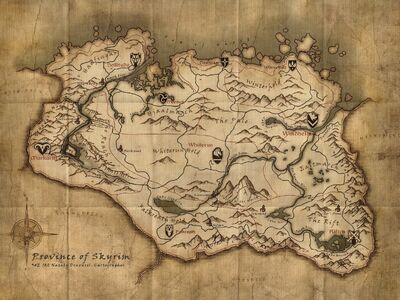
A map of Skyrim
Skyrim is a vast region set in the northern part of Tamriel. It is home to the Nords, large and hardy men and women who have a strong resistance to frost, both natural and magical. Skyrim was originally inhabited by a race of Mer called the Snow Elves, though after the Atmoran-Snow Elf War, the Snow Elves were destroyed and the Atmorans settled the land. It is bordered by Morrowind to the east, Cyrodiil to the south, Hammerfell to the southwest, and High Rock to the west. The island of Solstheim lies to the northeast of Skyrim.
History
Merethic Era
- Main article: Merethic Era
Skyrim, also known as the Old Kingdom or the Fatherland [1][2] is the home of the Nords and the setting for The Elder Scrolls V: Skyrim.
Expedition to Skyrim
During the Merethic Era, Ysgramor and the Atmorans he brought out of Atmora called the land Mereth, in recognition of the vast number of Mer that lived there. It was the first region of Tamriel to be settled by humans, who migrated there from the land of Atmora in the far north, across the Sea of Ghosts. According to legend, Ysgramor landed first at Hsaarik Head, at the extreme northern tip of Skyrim's Broken Cape. It is said that he and his companion were fleeing the civil war in Atmora, which at that time had a sizable population.[2]
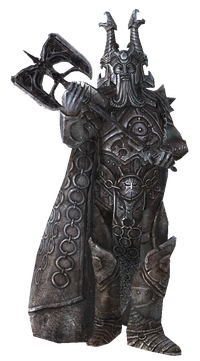
Ysgramor formed the Five Hundred Companions.
The Atmorans settled the area that in the future would be known as Winterhold hold; they eventually built a city in the region and called it Saarthal. For a long while, relations between the Snow Elves and the Atmorans were relatively peaceful.
Night of Tears
- Main article: Night of Tears
However, the Snow Elves saw that the Nords, with their considerably shorter life expectancy, fast rates of physical maturation and expedient (by Elvish standards) reproductive cycle, would eventually overtake them if left unchecked. At the time, men were viewed by Snow Elves as being primitive and animal-like, and it was seen as no great moral remission to stop the spread of a potentially disastrous invasive species, who would destabilize the Tamrielic ecosystem. However, there was a theory which raised the possibility of the Snow Elves' attack on Saarthal for another reason. The Atmorans had discovered something deep beneath the surface, when they were building Saarthal. The Atmorans tried to keep the secret of the artifact they found, but the Snow Elves learned of it. Thus, Elvish pogroms razed the city of Saarthal on what became known as the Night of Tears.[3] Only Ysgramor and his two sons survived, and escaped back to Atmora.
The Return
- Main article: The Return
When Ysgramor and his sons returned to Atmora, they told the stories and events that happened in Skyrim. The people of Atmora cried out in sadness and anger, and for revenge against the Snow Elves; the people were united with a common cause for war against the Elves. In addition, seeing the tenuous peace which had developed between the various factions, Ysgramor recognized the opportunity to turn their plight into a uniting force for the human race. Within a few years, Ysgramor was set to return to Skyrim with an army known as the "Five Hundred Companions", composed of the heroes of the Atmoran Civil War.[2] On the Day of Final Passage, the Five Hundred Companions left the port of Jylkurfyk to return to Skyrim.[4]
Atmoran-Snow Elf War
The Atmoran-Snow Elf War took place in the late Merethic Era. One famous battle, which occurred late in the war and happened to be the turning point for the Atmorans, was the Battle of the Moesring. During the battle, the Atmorans were winning and it appeared that they would be victorious, until the arrival of the Snow Prince. He rallied and led his forces into combat, inspiring the troops of the last remaining army of Snow Elves. Several of the greatest Nord warrior-heroes fell before the Snow Prince, which included Ingjaldr White-Eye, Ulfgi Anvil-Hand, Strom the White, Freida Oaken-Wand and Heimdall the Frenzied. The tide appeared to have turned for the Snow Elves, until the Snow Prince killed Jofrior. Finna, who was only twelve years of age and daughter of Jofrior, watched as her mother was slaughtered by the Snow Prince. In her rage and sadness, Finna picked up her mother's sword and threw it at the Snow Prince, which struck him in the breast and killed him. The death of the Snow Prince shattered the morality and motivation of the remaining Snow Elf warriors. Many Snow Elves fled, and those who remained on the battlefield were killed.[5]
The war would end shortly later with the purging of most of the Snow Elves in Skyrim and their civilization would be destroyed. The Five Hundred Companions, without much resistance, drove the Snow Elves out and were knighted in the foundations for the Ysgramor Dynasty. [6][7]
Founding of Whiterun
After the war against the Snow Elves ended, the Five Hundred Companions decided to break into separate groups to find their own way in the newly founded land. The crew of Jorrvaskr, led by Jeek of the River, journeyed around the new land until they came upon a mysterious yet wondrous sight; "a monument of a bird, whose eyes and beak were opened in flame." This monument that would soon later known be known as Skyforge, was older than the Snow Elves themselves. This great monument was about as old as Nirn and was "some remnant of the god's efforts to render a paradise in Mundus before the shattering of Lorkhan." A city was built up around Jorrvaskr, and this city was known as Whiterun, with the initial area around it later known as Whiterun Hold.[8]
Founding of Windhelm
Ysgramor and his group traveled eastwards, heading towards Yngol Barrow, and after stopping there, Ysgramor's eyes turned to the south, where a river met the sea. He decreed that he and his crew would built a great city, in monument to the glories of Mankind, and so he could look upon his son's final resting place and "feel that his line would know peace in this new home that was never known in Atmora." The city was built with a long bridge stretching across the White River, with much of the city made of stone. This city would be known as Windhelm, the City of Kings.[9]
Dragon War
- Main article: Dragon War
Disclaimer: There is not much information on the dragon government and its timeline. The lore would suggest that the rule of the dragons preceded the greater wave of Atmoran colonization, and there is also little information about the dragons' interaction with the Dwemer and Snow Elves and their activities outside of Skyrim.
- "When the populace rebelled, the dragon priests retaliated. When the dragon priests could not collect the tribute or control the masses, the dragons' response was swift and brutal. So it was the Dragon War began."
- ―The Dragon War, by Torhal Bjorik on the beginning of the Dragon War
When the Atmorans came to Skyrim, they brought with them their history and culture, including their religion. Their religion focused on the worship of animal gods, the chief deity of which was the Dragon. Just as Dragons ruled supreme in Atmora with Dragon Priests being their sub-leaders who did the actual ruling themselves, the same existed in Tamriel.[10]
At an unknown time, the people of Skyrim and all of Tamriel rebelled against the Dragons. At first, people died by the thousands.[10] Later, Kyne, the Nordic goddess of the Storm, intervened to help Mankind. She gave Paarthurnax (Character) the task of teaching Mankind the Voice.[11]
The tide began to turn in favor of the Humans, and eventually, Dragons began to be hunted down in large numbers as well. Mankind would win the Dragon War, with many Dragons killed and Dragon Cult dispersing and going into hiding.
First Era
- Main article: First Era
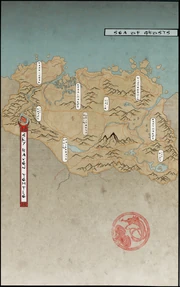
Akaviri map of Skyrim in the First Era.
Second Century
Snow Elves persisted within the borders of Skyrim until the reign of the Thirteenth of the Ysgramor Dynasty, King Harald, at the beginning of the First Era. King Harald was the first to relinquish all holdings in Atmora (until that time, the Nords of Atmora and Skyrim had been considered the same group), proclaiming that the people of Skyrim were an independent people.
Third Century
Vrage the Gifted started the expansion that would eventually lead to the First Empire of Men. Within fifty years of his reign, the Nords ruled all of Skyrim as well as parts of High Rock, Cyrodiil, and the Dunmer lands of Morrowind.[2][12] The acquisition of Morrowind was particularly bloody, still remembered in Morrowind.[2] The purpose of the formation of the Chimer-Dwemer kingdom of Resdayn was to expel the Nords.[13][14]
Fourth Century
The system which chose the successors to the Empire eventually proved to be its undoing. For a great while the Moot, a gathering of the lords of the many different Holds, chose the successor to the Empire. This lasted well until the death of King Borgas.[2]
In 1E 369, High King Borgas died during the Wild Hunt. His death helped start Skyrim's War of Succession.[2]
Fifth Century
First Battle of Red Mountain
In 1E 416, the Nords were expelled from Morrowind during the First Battle of Red Mountain (the Second Battle of Red Mountain would occur in 1E 700 and would have nothing to do with the Nords). The Nords lost all of their territory in Morrowind, and their armies suffered a disastrous loss to the combined forces of the Chimer and the Dwemer.
End of the War of Succession
- "Subdued the foul dragon Numinex,
reunited Skyrim after the war of
Succession, and conquered the
barbarous Reach." - ―Windhelm Palace of the Kings Plaque
In 1E 420, the Skyrim War of Succession ended with the Pact of Chieftans and the crowning of Olaf One-Eye as High King.[2][15][16]
Third Era
- Main article: Third Era
Fifth Century
In the beginning of the Fifth Century of the Third Era, the Oblivion Crisis started when Mehrunes Dagon attempted to enter Tamriel in his "true and terrible form." Oblivion Gates opened up all over Tamriel, and a massive war between Mortals and Daedra erupted. Though most of the fighting took place in Cyrodiil, Oblivion gates opened up all across Tamriel.[17]
Fourth Era
- Main article: Fourth Era
First Century
- "Untithed to any thane or hold, and self-governed, with free worship, with no compensation to Skyrim or the Empire except as writ in the Armistice of old wheresoever those might still apply, and henceforth let no Man or Mer say that the Sons and Daughters of Kyne are without mercy or honor."
- ―Skyrim's offer of Solstheim to Morrowind in 4E 16[src]
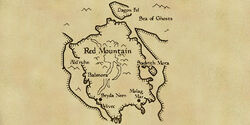
Map of Red Mountain.
During the First Century of the Fourth Era, the Red Mountain in Morrowind erupted, which caused widespread destruction and death. Cities were destroyed, many people died, with most of Morrowind destroyed. The event took place from 4E 5[18] to 4E 6.[19]
In 4E 16 the High King of Skyrim gave the island of Solstheim to the Dunmer, giving the refugees coming from Morrowind a place to live.[20][21] Four years later, in 4E 20, the Decree of Monument was signed by the Jarls to "decree this site as a monument to the struggle of those who fled their native home of Morrowind in the time following the Red Year."[22]
Second Century
Forsworn Uprising
In 4E 174, a group of Reachmen launched an uprising in which they took the city of Markarth. This event would later be known as The Forsworn Uprising. Since the Empire was fighting against the Third Aldmeri Dominion in Cyrodiil with the Great War raging on, Markarth was undefended and was thus left open for attack. The Reachmen who took control of Markarth took over the government administration and created an independent kingdom for The Reach.[23]
Markarth Incident
Two years later, in 4E 176, Skyrim's federal government organized a militia force led by Ulfric Stormcloak, who were to retake Markarth. The militia group eventually retook Markarth, and drove the remaining Reachmen who rebelled out of the city. Those remaining people became the Forsworn, who swore revenge against the Nords for preventing them a life of independence.[23][24]
Third Century
- "When the sons of Skyrim would spill their own blood."
- ―Esbern, describing the Skyrim Civil War[src]
- "The World-Eater wakes, and the Wheel turns upon the Last Dragonborn..."
- ―Prophecy of the Dragonborn[src]
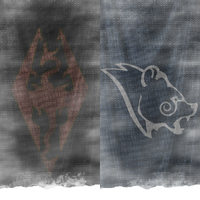
The banners of the Imperial Legion and the Stormcloaks.
The Third Century of the Fourth Era in Skyrim was a time to be alive, because the events that took place would be remembered for a very long time.[25] In 4E 201, two events occurred concurrently; the Skyrim Civil War and the Dragon Crisis. During this time, Skyrim and its people finally revolted against the Imperial Empire and the Third Aldmeri Dominion. At the start of the war, the Holds of Eastmarch, The Pale, The Rift and Winterhold Hold rose up and revolted against the Empire, while the Empire controlled Haafingar, Hjaalmarch, The Reach and Falkreath Hold. Whiterun Hold was neutral in the war and refused to join either of the two contestants in the war. Skyrim was divided, and a war of succession was raging on.
In addition, the Dragon Crisis occurred, during which Dragons returned to Tamriel.[24] No Dragon had made an appearance in Tamriel for over a thousand years. This dragon made its first Fourth Era appearance at Helgen, during which the dragon destroyed the entire town and killed nearly everyone there, except for the people inside the fort and an unknown prisoner.[26]
Geography
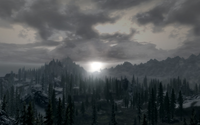
Skyrim features arctic tundra, mountains, and forests.
Skyrim is the fourth largest country in Tamriel with an area of roughly 105'500 sq. miles, it features many different terrain types, including tundra plains, forests, highlands and mountainous regions. It is the most rugged region on the continent; not only containing five of the highest peaks in Tamriel, but also very snowy and cold. Only in the western reaches are there some measure of flat land, where most of the population resides. The rest of Skyrim is vertical; mountains, cliffs, and deep valleys. A variety of crops are raised in Skyrim, from wheat to the hardy snowberry.
Of note is that the particular climate of Skyrim makes it the only region in Tamriel, outside of the most northern reaches of High Rock and Morrowind, suitable for the brewing of the infamous alcoholic beverage Nordic Mead, also known simply as "Rotgut". This is because that, in addition to the local availability of certain ingredients, several times during the distillation process, the substance must be subjected to extreme cold temperatures, so that it may freeze and refreeze. The drink is noted for the distinct "cold" taste, similar to extraordinarily strong mint, which persists as a feeling of ice in the stomach, as well as for the very deleterious nature of its content. Nordic Ale is illegal throughout the Empire, but this does not stop many proprietors from stocking smuggled bottles for those brave enough to try a mug.
Skyrim also sported a few numbers of caves, caverns and vales. One of the biggest caverns in Skyrim was Blackreach, or Fal Zhardum Din in Dwemeris, which translated to Blackest Kingdom Reaches.[27] Blackreach was a massive cavern which contained a city, one that was built by the ancient Dwemer. Blackreach was theorized to be the capital of the Dwemer empire, and was connected to three other Dwemer cities: Alftand, Raldbthar and Mzinchaleft. This massive cavern-city was enormous, its size beyond any other cave or cave network in Skyrim. A staggering variety of ore veins, flora, fauna and animals were found in Blackreach, many of them unique to the location.
Flora and Fauna
Flora
A vast number of types of flora was found throughout Skyrim. Flora could be found anywhere in Skyrim, even in the coldest, windiest and harshest of locations. Flora such as Snowberries and Frost Mirriam are capable of surviving in cold, harsh conditions. There were nine types of Fungi found in Skyrim. These could be found in caves, caverns and networks beneath the surface of Skyrim.
One of the inquiring and interesting floras of Skyrim was the Nirnroot. Nirnroot typically grew near fungi and water resources, and depended on water and sunlight to survive. This rare plant was light green and emitted a very bright glow, as well as chiming sound. Nirnroot flourished on Skyrim and all of Tamriel until the event known as the Sun's Death occurred in 1E 668, which catastrophically affected almost all plant life, including Nirnroot. Nirnroot depended on water and sunlight to survive, and after Sun's Death occurred, the Nirnroot's normal growth cycle was interrupted by the lack of sunlight for a full year.
The Crimson Nirnroot was a variant of the Nirnroot, which only grew in Blackreach. Crimson Nirnroot emitted a glow and chime sound just like the regular Nirnroot, but its natural color was red and could naturally reproduce itself. On Rain's Hand of 4E 2, a conference was held at the Alchemical Symposium. During the conference, Master Alchemist Sinderion delivered a speech on the Nirnroot in which he presented the notes of noted Herbalist Chivius Regelliam. Regelliam developed a theory which stated that the Nirnroot was entering evolution; the plant was gaining an ability to "preserve itself." When the volcanic ash mixed with the fertile soil of Cyrodiil, the Nirnroot was able to gain the aforementioned ability. Sinderion supported this theory and gave evidence on it, and recommended that funds should be used for a project to study the Nirnroot to find a way to save it from extinction.[28][29]
Fauna
- Main article: Creatures (Skyrim)
A variety of animals lived in Skyrim throughout the lands. From domesticated animals to animals living in the wild, there was a huge variety in the creatures of Skyrim.[24]
Some animals were domisticated by the Nords. These animals included the Dogs, Horses, Chickens, Cows and Goats. The horses of Skyrim were hardy and strong, and made up for endurance what they lacked in speed. Horses and horse-drawn carriages were commonly used as methods of transportation. Both were capable of tackling on the harsh terrain and climate with ease.[24]
Holds
- Main article: Hold
Holds were the nine administrative sections of Skyrim.[2][30] Scattered across the rugged landscape of Skyrim were five major cities and four minor ones, as well as minor towns, villages and settlements. The presence of more numerous and smaller cities gave the land a more natural, rural feel than the somewhat urbanized Cyrodiil.
The Pale
- Main article: The Pale
Dawnstar
- Main article: Dawnstar (Skyrim)
Dawnstar.
A garrison town on the northern coast of Skyrim, Dawnstar is the trade center of the region. It was named capital of the Pale after the destruction of a fortress in Dawnstar during 2E 283 that Potentate Versidue-Shaie declared martial law, leading to one of the most brutal and bloody periods in the history of Tamriel. Dawnstar is one of the northern most cities in Skyrim along with Solitude and Winterhold.
Falkreath Hold
- Main article: Falkreath Hold
Falkreath
- Main article: Falkreath (Skyrim)
Falkreath.
A city in south-western Skyrim, Capital of Falkreath Hold. Close to the border with both Cyrodiil and Hammerfell. Just across the border in Hammerfell lies the town of Elinhir. Falkreath is known for its cemetery, which dominates the southern part of the town. Werewolves have been heard in Falkreath.
The Reach
- Main article: The Reach
Markarth
- Main article: Markarth
- "Nothing ever changes in the City of Stone, and that's just fine."
- ―The City of Stone[src]
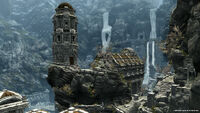
Markarth.
A city in west-central Skyrim, Markarth was the capital city of The Reach. Markarth was notable for possessing the Imperial College of the Voice, which was founded by Tiber Septim to restore the Voice to the art of warfare. Half of the town was controlled by a wealthy family known as the Silver-Bloods. Violence runs rampant throughout most of the city due to the Forsworn.
Hjaalmarch
- Main article: Hjaalmarch
Morthal
- Main article: Morthal

Morthal
A town in west-central Skyrim, capital city of Hjaalmarch, close to both Dragon Bridge, and Solitude. The mage, Falion, who can cure Vampirism, is located there. The current Jarl in Morthal is Jarl Idgrod Ravencrone.
The Rift
- Main article: The Rift
Riften
- Main article: Riften (Skyrim)
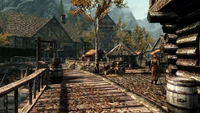
Riften.
Also known as Rifton, Capital of The Rift this town is located in south-eastern Skyrim, close to the province's borders with both Cyrodiil and Morrowind. Home to the Skyrim Thieves' Guild, it was in Riften that Barenziah joined the Guild during her return to Morrowind from exile in Skyrim.
Maven Black-Briar is the most influential person in Riften, and has both the Riften Guard and the Jarl in her pocket, as well as connections in both the Thieves Guild and the Dark Brotherhood.
Haafingar
- Main article: Haafingar
Solitude
- Main article: Solitude (Skyrim)
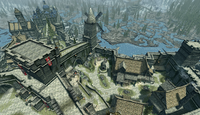
Solitude.
Solitude is the center of Imperial influence within Skyrim and capital city of Haafingar. Castle Dour is located there, from which General Tullius runs the Imperial Legion. The royalty are housed within the Blue Palace. Solitude is located far northwest of the center of the map. The home of the famous Bards' College, Haafingar is also one of Skyrim's few natural harbors and chief ports; ships from up and down the coast can be found at her crowded quays loading timber and salted cod for the markets of Wayrest, Anvil, and Senchal.
Founded during Skyrim's long Alessian flirtation, the Bards' College continues to flaunt a heretical streak, and its students are famous carousers, fittingly enough for their chosen trade. Students yearly invade the marketplace for a week of revelry, the climax of which is the burning of "King Olaf" in effigy, possibly a now-forgotten contender in the War of Succession. Graduates have no trouble finding employment in noble households across Tamriel, including the restored Imperial Court in Cyrodiil, but many still choose to follow in the wandering footsteps of illustrious alumni such as Callisos and Morachellis.
Whiterun Hold
- Main article: Whiterun Hold
Whiterun Hold was the largest of the nine holds, and was located at the center of mainland Skyrim. The Hold featured a wide variety of geographical features, including rolling plains, green hills and snow-capped mountains, including the Throat of the World, which was the tallest mountain with the highest peak in all of Tamriel. Whiterun Hold was located at the center of Skyrim, and was the hub of trading and a core part of the province's economy.[31] Whiterun Hold's major city was Whiterun, and featured two other settlements, Riverwood and Rorikstead.
Whiterun Hold's economy was helped by the major trading and business in Whiterun City, the sawmill business in Riverwood, and five farms, three of which were located just outside of Whiterun City, while the other two were located in Rorikstead.
Whiterun
- Main article: Whiterun (Skyrim)
- "The Plains District of Whiterun is home to the city's shops and market, while the Wind District is mostly a residential district. The Jarl's palace, Dragonsreach, dominates the Cloud District."
- ―Proventus Avenicci[src]
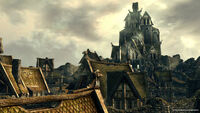
Whiterun.
A city in central Skyrim and capital of Whiterun Hold. It is the trade hub of Skyrim. The young Barenziah, during her escape, took shelter here for a week with a young lover during her return to Mournhold.
This hold contains Whiterun and High Hrothgar and was once referred to as the "Imperial City of Skyrim" before it underwent several acts of chaos including a dynastic feud, attacks by Hörme bandits and Frost Trolls and a series of annihilating winters of alternating floods, droughts, and fires. A self-proclaimed priestess of Lorkhan, Jsashe the Witch-Queen, controls the county and the local witches' coven. It is interesting to note that the local giant population seems to use the tundra outside Whiterun as a pasture of sorts for their mammoth herds, and a place to set camp, like Bleakwind Basin.
Winterhold Hold
- Main article: Winterhold (Hold)
Winterhold
- Main article: Winterhold (Skyrim)
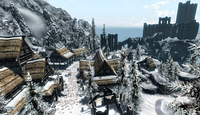
Winterhold.
The capital city of Winterhold was once a wealthy and influential city and county in north-eastern Skyrim, Winterhold is heavily affected by Dunmer ways and ideas, being close to the border. It contains the Ysmir Collective and the well known College of Winterhold. Winterhold's current Jarl is Korir.
Due to the Great Collapse, most of the historic city sank into the ocean two hundred years prior to the dragon attacks. It is arguably the smallest hold capitol, with only a tavern, the Jarl's Longhouse and the College of Winterhold.
Eastmarch
- Main article: Eastmarch (Skyrim)
Eastmarch was located along the eastern border with Morrowind. The northern part of Eastmarch featured snowy tundras and mountains, while the central and southern areas of the Hold was volcanically active. The western part resembled much of central Skyrim, while the eastern part was connected along the Velothi Mountains. Eastmarch's major city, Windhelm, was located in the northern part of the hold.
A smaller settlement, known as Kynesgrove, was located south of Windhelm. Eastmarch's economy was supported by three farms, Brandy-Mug Farm, Hlaalu Farm and Hollyfrost Farm, all located just outside of Windhelm. Eastmarch was also supported by Mixwater Mill and four mines: Darkwater Crossing, Goldenrock Mine, Steamscorch Mine and Gloombound Mine.
Windhelm
- Main article: Windhelm (Skyrim)
Windhelm.
Windhelm was once the capital of the First Empire of Skyrim, but as of the Fourth Era, it was the capital city of Eastmarch. The palace of the Ysgramor dynasty still dominates the center of the Old City. Windhelm was sacked during the War of Succession,[2] and again by the Akaviri army of Ada'Soon Dir-Kamal;[2] the Palace of the Kings is one of the few First Empire buildings that remain. Today, Windhelm remains the only sizable city in the otherwise determinedly rural Hold of Eastmarch, and serves as a base for Imperial troops guarding the Dunmeth Pass into Morrowind.
Government
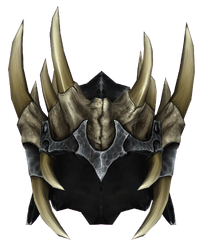
The Jagged Crown is a symbol of power for the rulers of Skyrim.
- "Maw unleashing razor snow,
Of dragons from the blue brought down,
Births the walking winter's woe,
The High King in his Jagged Crown." - ―Ancient Nordic verse describing the Jagged Crown[src]
The collected province of Skyrim is ruled by the High King (or Queen) and their consort. Each hold is ruled by a Jarl. Until the Stormcloak Rebellion and Skyrim Civil War, the province was included in the Empire of Tamriel. However, by the beginning of the Fourth Era, only half of Skyrim counts asImperial territory. While under this banner, Skyrim enjoyed military aid from the Emperor's army and inclusion in world affairs, as part of the Elder Council. The High King and each Jarl held a seat on the council.[24][32]
The Jagged Crown was a symbol of leadership and power of a High King or High Queen. It was made out of the teeth and bones of Dragons and was an ancient relic of the Nords. It was believed to date back to the time of King Harald. The last High King to wear the crown was King Borgas and was lost during the War of Succession.[33]
There were no known laws or legal documents of Skyrim. There were some surveys, censuses and records used by the government, such as the Book of Life, which was a census that kept track of people and livestock in a certain region.[34] The government also kept records of cities' general status and economic production. One such survey was the Survey of the Holdings of Jarl Gjalund, taken down during the First Era by Slafknir the Scribe, under the rule of Jarl Gjalund.[35] The following is the actual survey itself.
Survey of the Holdings of Jarl Gjalund
As Witnessed by Slafknir the Scribe, so Sworn by the Old Gods and the New
Whiterun - (AHROL-SE-DOVAH: Hill of Dragon.)
The Jarl's Holding, with Plentiful Water and Pasturage. Home of Jorrvaskr, the Far-Famed Hall of the Companions.
Rorik's Steading - (RORIK-HOFKAH: Rorik Steading)
A Small Farmstead in the Western Plains. Grain, Leather, Horses.
Granite Hill -![]()
(QUESTHSEGOL AHROL: Stone Hill)
Three Farms and an Inn, just north of the Falkreath. A Market is Held here Weekly.
H'roldan - (AHROL-DAN: Hill ?)
A Spacious Wooden Hall and Pasturage, recently Seized from the Reachmen. Silver and Iron as Tribute from the Natives.
Bromjunaar - (BROM-JUN-AAR: North King Servant)
An Old Settlement, much Reduced from Former Days. Lumber and Stone.
Korvanjund - (KORVANJUND)
A Small Forified Settlement. Hides and Meat.
Volunruud - (VOLUNRUUD)
A Fortified Wooden Hall near Giants' Gap. Meat and Worked Ivory.
Hillgrund's Steading - (HILLGRUND-HOFKAH: Hillgrund Steading)
A Large Farmstead Near the Base of the Monahven. Grain, Mead, Honey.
Armed Forces
A Whiterun guard.
Skyrim appeared to have no national armed forces. Each Hold had its own section of Hold Guards who acted as both a national guard and police force. These soldiers were the first line of defense against any opposing force who threatened Skyrim and her people. After the Skyrim Civil War erupted in 4E 201, the Hold Guards of Skyrim were divided just as Skyrim herself was, with Haafingar, Hjaalmarch, The Reach and Falkreath Hold under Imperial control and Eastmarch, The Pale, The Rift and Winterhold Hold under Stormcloak control.
Economy
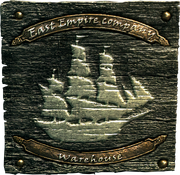
The East Empire Company symbol.
Skyrim was a wealthy and powerful province; the hold of Haafingar had always been one of the richest and most influential regions. Solitude was the capital of both Haafingar and Skyrim, and so dominates politically, but also economically. Recently, Solitude has grown ever more powerful, controlling much of the northern coastline following King Thian's alliance by marriage with Macalla, the Queen of Dawnstar.[36] It has sought to expand its influence further by annexing several former Imperial fiefs, such as the island of Roscrea, ruled directly by the Emperor since Uriel V conquered it in the 271st year.[37] There are also influences from Morrowind because refugees from Morrowind escape there, bringing new ideas, cultures, and stimulating the economy.
In some cities, a citizen becomes a part of the economy by either logging or blacksmithing. In the fourth era, Skyrim was politically unified until the outbreak of civil war, which pitted the Eastern Holds against the Western Holds. Though this, coupled with the Great Collapse, has caused some damage to Skyrim's economy, the city of Riften has become an industrial powerhouse, producing mead and fish.[38] This has led to some political corruption, however, but on the whole, Skyrim is one of the more powerful and wealthy nations on Tamriel.
There were many forms of economic production in Skyrim. This included agriculture (farming), which was common despite the harsh and cold conditions, as well as grain production, mining, stone-cutting and logging. There was also fishing, honey farming and food and mead production. In Skyrim, there were many farms, Grain Mills, Mines, saw mills, docks and ports that produced goods and services. In addition, the trading and shipping industries were another part of Skyrim's economy. In each major city in Skyrim, of which there were five of them, there was a central marketplace where business, trading and social activities took place.
Some cities, towns and villages produced specific goods and services. During the First Era, Rorik's Steading (Rorikstead) produced grain, leather and horses, Korvanjund produced hides and meat, Volunruud produced meat and worked ivory, Bromjunaar produced lumber and stone, Granite Hill held a weekly market and Hillgrund's Steading (Ivarstead).[35]
The East Empire Company was a multi-national, monopolistic trading and shipping company based out of Cyrodiil. The East Empire Company essentially dominated the shipping and trading industry in Skyrim. They controlled the flow of ships, goods and trade and business coming into the ports of Skyrim.
The Thieves Guild was an organized guild of thieves who operated based out of organized crime. They were headquartered in the Ratway beneath Riften, and had major effects on Skyrim's economy, whether it was positive or negative.
Skyrim used the Septim, which was the main currency used in Cyrodiil and throughout all of the Empire.
Culture
Skyrim and her people, the Nords, had a diverse culture that spread across multiple aspects, such as general culture, holidays and festivals, music, religion, architecture and infrastructure and education. Some pieces of culture even dated back to the Merethic Era used by the Atmorans, the Nords' ancient ancestors.
There was a spiritual relationship between Nords and breathing, which was associated with the goddess Kynareth. Though the art of speech was usually associated with the goddess Dibella, the art of Thu'um, or Storm Voice,[39] was associated with Kynareth, who gave Men the ability to speak.[40] Nords considered themselves to be the children of the Sky. They called Skyrim the Throat of the World, because it was where the sky first brought the North Winds upon land and formed them. Breath and the voice was the vital essences of a Nord; the art of breathing, speech and articulation was with them.
Nearly all Nords had the capability to speak, but some had the capability of using Thu'um, or Storm Voice. The power of those Nords could be articulated into a Shout.[41] The Way of the Voice was a pacifist philosophy developed by Jurgen Windcaller. The philosophy preached the Thu'um should only be used for worship and glory of the Gods rather than martial exploits. Jurgen Windcaller first developed this philosophy after the First Battle of Red Mountain in 1E 416. He then founded the The Greybeards, a monastic group of Tongues who practiced the Way of the Voice.[2][40]
There was a relationship between Nords and combat skills, whether it was one-person melee weapons, archery, blocking, heavy weapons, hand-to-hand combat. Nords were simply just associated with battle skills, the art of combat, improving battle tactics and increasing overall experience of combat. Nords and their culture also focused on quests for honor and glory.
Saunas were popular in Skyrim.[42]
Music
Many songs were found in Skyrim's culture; some notable songs included Ragnar the Red, the Song of the Dragonborn, The Dragonborn Comes and Tale of the Tongues. Music was also popular in relation to war and propaganda. In the Third Century of the Fourth Era, when the Skyrim Civil War was taking place, two songs were produced with either song supporting a side. The Age of Aggression was for the Empire and The Age of Oppression was for the Stormcloaks and Skyrim.[43]
These songs were sung by Bards in Inns and Taverns all across Skyrim. The Bards College (Location) in Solitude was a school for Bards.
Many songs were still sung by people in the modern era that were sung by people of the Merethic Era and the First Era. One very notable song of the past was King Olaf's Verse. The verse, written by Bard Svaknir, criticized King Olaf One-Eye and his adventures and referred to his adventures as "lurid and false." In response, King Olaf One-Eye ordered Svaknir to be imprisoned and all copies of his verse to burn.[44] In 4E 201, the Last Dragonborn joined the Bards College, and his or her first task was to retrieve the last known copy of King Olaf's Verse in Dead Men's Respite.
Queen Elisif the Fair banned the Burning of King Olaf, a festival of the Bards College, and the Bards desired for the festival to take place, and not just for them but for all of Solitude and Skyrim. Viarmo and the Last Dragonborn went to Elisif the Fair and presented to her King Olaf's Verse. Elisif soon allowed holding of the Burning of King Olaf festival. The festival was to be held that day, and for all days in the future when the festival was to take place.[45]
Festivals and Holidays
A few notable holidays and festivals were customary in Skyrim and in Nordic culture. One notable festival was the Feast of the Dead, which was held on the 13th of Sun's Dawn in Windhelm to honor Ysgramor and the Five Hundred Companions. During the festival, the names of the Five Hundred were recited.[2] Another notable festival in Skyrim was the Burning of King Olaf.
Religion
There were two religious pantheons of Skyrim, both worshiped in different time periods throughout Skyrim's history. The first was the Ancient Nordic Pantheon, worshiped during the Merethic and early First Era.[10] The second was the Nordic Pantheon, revered during the rest of Skyrim's history.
The Nordic Pantheon consists of various deities, resembling or drawing influence from the Nine Divines. Specific deities venerated by Skyrim and her people include: Alduin, Dibella, Orkey, Tsun, Mara, Stuhn, Kyne, Jhunal, Shor, Ysmir, Herma-Mora, Maloch.[39] Shor is considered the father deity of the providence, as opposed to Akatosh, the chief Divine of Cyrodiil. Some scholars report that Akatosh and Alduin are the same deity, while others disagree.[39][46][47] Conversely, the Ancient Nordic Pantheon venerated animal gods; the deities were the hawk, wolf, snake, moth, owl, whale, bear, fox, and the dragon.[39]
Sovngarde is believed to be the Nordic afterlife created by Shor. When Nords, as well as anyone who believed in the Nordic Pantheon, died a heroic and honorable death, they ascended to Sovngarde.[48]
Daedra worship is rare in Skyrim. The main pantheon consists of Herma-Mora, an Atmorian demon who some claim is the incarnation of Daedric Prince, Hermaeus Mora. Mephala, the Daedric Princess and webspinner, is Herma's sister, supporting claims that he is a Daedric Prince. Maloch, an incarnation of Malacath, is the patron of the ostracized. This Daedric Prince was brought to Skyrim by the Orcs. Other Daedric Princes worshiped in Skyrim include Azura—whose followers fled Morrowind after receiving spiritual dreams from their liege;[49] Nocturnal—worshiped by the Nightingales; Namira—worshiped by a cult of cannibals; and Hircine, largely patronized by lycanthropes.[24]
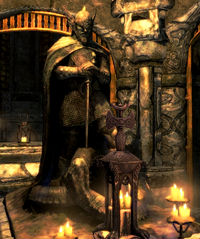
One of the last Shrines of Talos in Skyrim.
Talos worship
Because Tiber Septim liberated Skyrim from the elves, many consider his divine apothesized form, Talos, as worthy of veneration. Worship of Talos was prevalent in Skyrim until the Thalmor and the Elder Council signed the White-Gold Concordat as a treaty to the Great War conflict. Within the document contained explicit demands by the Third Aldmeri Dominion to uproot the worship of Talos in Cyrodiil and its territories. Skyrim, at the time, was a territory of the Empire of Tamriel, its High King being a member of the Elder Council. Loyalists supported the efforts of Imperial Legion and the Thalmor to eradicate Talos worship in Skyrim, although rebellious groups such as the Stormcloaks refused to relinquish these beliefs. Popular insurgents included the Jarls Elisif the Fair (of Solitude) and Ulfric Stormcloak (of Windhelm). Sometime after the Concordant was signed into law, the shrine of Talos in the Temple of the Divines was vandalized and removed.[50]
Architecture and Infrastructure
The architecture and infrastructure of Skyrim was a mix of rural and urban; part of Skyrim was complete wilderness that was untamed, there were nine cities spread across the nation. Of the nine cities in Skyrim, there were five that were more urbanized, heavily populated and more city-like, and the other four were smaller, less populated and more rural in nature.[24]
The actual architecture of the buildings varied, but it was unknown what it depended upon. The city of Markarth was originally built by the ancient Dwemer. The buildings were made of stone and the unique metal known only to the Dwemer. After the Dwemer disappeared in 1E 700, people started to settle into Markarth, so the Nords who settled the city did not have to use their cultural styles of architecture and infrastructure.
Ancient Nordic architecture included longhouses, with "each beam and cornice festooned with carvings of dragons, bulls, boars, leering wild men, and dancing, long-tressed women."[51]The Ancient Nords, known as the Atmorans, built massive structures called Word Walls. Whether it was out of fear or respect, the Ancient Nords learned the language and writing system of the Dragons (Lore).[52] One purpose of these Word Walls was to teach Words of Power to those who could learn and use Shouts.[24]
There was also Akaviri architecture present in Skyrim. Sometime during the First Era (1E), Sky Haven Temple was constructed for and by the Akaviri Dragonguard. In 1E 2812, Emperor Reman II permitted the construction of Alduin's Wall within Sky Haven Temple. Alduin's Wall was a massive stone mural built to record all of the Akaviri's accumulated dragon-lore and the Prophecy of the Dragonborn. Sky Haven Temple and Alduin's Wall was a testament to Akaviri architecture and sculpturing, and was considered to be some of the best preserved examples of early Akaviri structures and sculptures.[53][54]
Education
Three colleges exist in Skyrim: the Imperial College of the Voice,[2] the Bards College, and the the College of Winterhold.
Other provinces
Appearances
References
- ↑ 1.0 1.1 Provinces of Tamriel
- ↑ 2.00 2.01 2.02 2.03 2.04 2.05 2.06 2.07 2.08 2.09 2.10 2.11 2.12 2.13 Pocket Guide to the Empire, First Edition: Skyrim
- ↑ Night of Tears (Book) - Dranor Seleth
- ↑ Songs of the Return, Vol 2
- ↑ Fall of the Snow Prince - Lokheim
- ↑ The Falmer: A Study - Ursa Urthrax
- ↑ Fall of the Snow Prince
- ↑ Songs of the Return, Vol 7
- ↑ Songs of the Return, Vol 19
- ↑ 10.0 10.1 10.2 The Dragon War - Torhal Bjorik
- ↑ Seven Thousand Steps Etchings
- ↑ Frontier, Conquest, and Accommodation: A Social History of Cyrodiil - University of Gwilym Press, in 3E 344
- ↑ Pocket Guide to the Empire, First Edition: Morrowind
- ↑ Nerevar at Red Mountain - Alandro Sul
- ↑ Olaf and the Dragon - Adonato Leotelli
- ↑ Windhelm Palace of the Kings Plaque
- ↑ Events of The Elder Scrolls IV: Oblivion
- ↑ History of Raven Rock, Vol. I - Lyrin Telleno
- ↑ Lymdrenn Tenvanni's Journal
- ↑ Events of The Elder Scrolls V: Dragonborn
- ↑ An Elder Scrolls Novel: Lord of Souls
- ↑ Decree of Monument
- ↑ 23.0 23.1 The Bear of Markarth - Arrianus Arius
- ↑ 24.0 24.1 24.2 24.3 24.4 24.5 24.6 24.7 Events of The Elder Scrolls V: Skyrim
- ↑ Dialogue with Viarmo
- ↑ Events of Unbound
- ↑ Dwemer Inquiries Vol III - Thelwe Ghelein
- ↑ Sinderion's Field Journal
- ↑ The Nirnroot Missive - Sinderion
- ↑ The Holds of Skyrim: A Field Officer's Guide, For Use By Officers of the Imperial Legion
- ↑ Loading Screens (Skyrim)
- ↑ Skyrim's Rule: An Outsider's View - Abdul-Mujib Ababneh
- ↑ Dialogue with Galmar Stone-Fist
- ↑ A History of Daggerfall - Odiva Gallwood
- ↑ 35.0 35.1 Holdings of Jarl Gjalund - Slafknir the Scribe
- ↑ Pocket Guide to the Empire, Third Edition: Skyrim
- ↑ Brief History of the Empire, Book III - Stronach K'Thojj III, Imperial Historian
- ↑ Nords of Skyrim - My People, My Pride - Hrothmund Wolf-Heart
- ↑ 39.0 39.1 39.2 39.3 Varieties of Faith in the Empire - Mikhael Kurkuxor
- ↑ 40.0 40.1 Dialogue with Arngeir
- ↑ Children of the Sky
- ↑ The Infernal City pg 196
- ↑ Songs of Skyrim - Giraud Gemane
- ↑ Dialogue with Giraud Gemane
- ↑ Events of Tending the Flames
- ↑ The Alduin/Akatosh Dichotomy: Book Seven of 2920, The Last Year of the First Era - Alexandre Simon, High Priest of the Akatosh Chantry, Wayrest
- ↑ Alduin is Real - Thromgar Iron-Head
- ↑ Sovngarde, a Reexamination - Beridette Jastal
- ↑ Dialogue with Aranea Ienith
- ↑ Dialogue with a priest in the Temple of the Divines.
- ↑ An Elder Scrolls Novel: The Infernal City pg 121
- ↑ Dragon Language: Myth no More - Hela Thrice-Versed
- ↑ Annals of the Dragonguard - Brother Annulus
- ↑ Dialogue with Esbern (Skyrim)
